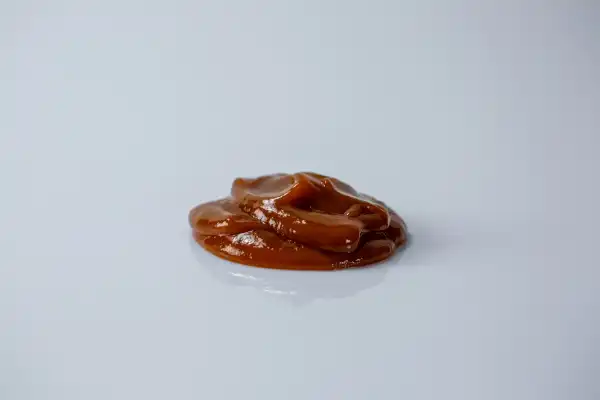Access our First Foods® Database in the Solid Starts App.
Learn moreKetchup
Condiment
Age Suggestion
6 months
Iron-Rich
No
Common Allergen
No

When can babies have ketchup?
Ketchup may be introduced as soon as baby is ready to start solids, which is generally around 6 months of age, as long as it is free of honey, which poses a risk of infant botulism. While ketchup can be high in sodium, a taste here and there as part of a variety of foods is not a cause for concern.
Ketchup is often thought to be an American invention, but the condiment’s history and identity is much more complicated. Through trade and colonization, a sauce made of fermented fish known as ke-tchup or kê-tsiap spread from East Asia to Europe. In England, catsup or ketchup became a catch-all term for tangy sauces with notes of umami and sweetness made from a variety of ingredients, from mushrooms to green chestnuts. When colonization introduced tomatoes from the Americas to Europe, ketchup began to look like the modern version that is beloved worldwide today, with ingredients added to make the product more shelf-stable.
How do you serve ketchup to babies?
Every baby develops on their own timeline, and the suggestions on how to cut or prepare particular foods are generalizations for a broad audience.
6 months old +:
While ketchup can be high in sodium, sharing a taste here and there as part of a variety of foods is not a cause for concern. You can also feel free to cook with ketchup in the family’s meals as desired. Just make sure that ketchup is honey free due to the risk of infant botulism.
12 months old +:
Feel free to cook with ketchup in the family’s meals as desired, and spread on the child’s food if you’d like. At this age, you can also offer a small cup of ketchup as a dip—just know that the child is just as likely to eat or drink the ketchup on its own, so consider offering a very small amount.
24 months old +:
Serve ketchup in any dish that you want to share with the child or on the side in a small cup for dipping. At this age, you can also help the child squeeze or spread ketchup on their own food, which can help engage toddlers in the meal.
Videos
Is ketchup a choking hazard for babies?
No. Ketchup presents a low risk when safely prepared for a child’s age and developmental ability, though, in theory, an individual could choke on any food. To reduce the risk, prepare and serve ketchup in an age-appropriate way as described in the How to Serve section. As always, make sure you create a safe eating environment and stay within an arm’s reach of baby during meals.
Learn the signs of choking and gagging and more about choking first aid in our free guides, Infant Rescue and Toddler Rescue.
Does ketchup contain common allergens?
No, ketchup does not typically contain common food allergens. However, be aware that certain varieties of ketchup may contain common food allergens, including finned fish, soy, or wheat, so be sure to read the label carefully.
Ketchup may contain sulfites, and while sulfites are not a common allergen, certain individuals, particularly those with asthma, may have allergy-like reactions to added sulfites. If sulfites are a concern, avoid ingredients such as sulfur dioxide, potassium bisulfate, potassium metabisulfite, sodium bisulfite, sodium metabisulfite, and sodium sulfite, to name a few.
Note that acidic foods, including the tomato and vinegar in ketchup, can cause a harmless rash on skin that comes into contact with the juices and sometimes contribute to diaper rash. Try applying a thin layer of barrier ointment (such as pure petroleum jelly or a plant-based oil/wax balm) to baby’s face and bottom to help prevent contact rashes.
Prior to sharing ketchup with a child, it is important to introduce any common food allergens in the condiment and rule them out as an allergy. This way, when you are ready to offer ketchup, you’ll be confident that the child has already safely eaten these common food allergens. This approach will also help you identify which food is responsible if the child has an allergic reaction when eating a dish that contains ketchup combined with other ingredients.
As you would when introducing any new food, start by offering a small quantity for the first few servings. If there is no adverse reaction, gradually increase the quantity over future meals.
Is ketchup safe for babies?
Yes. As long as the ketchup is free of honey, which carries a risk of infant botulism, ketchup is safe for babies once they are ready for solids. While ketchup can be high in sodium, a taste here and there as part of a variety of foods is not a cause for concern.
What are some great first foods for babies?
There are many wonderful options. Look for foods that are easy for baby to feed to themselves, that are low in choking risk, and that offer nutrients babies need, such as iron. A few of our favorite first foods include cooked broccoli, oatmeal, and mango pits.
Do I need to start solids with purees?
You can if you’d like, but there's no developmental need to start with textureless food. Babies can be served modified versions of what you eat. Use our First Foods Database to find how to safely serve any food.
Our Team
Written by
Expert Tips Delivered to Your Inbox
Sign up for weekly tips, recipes and more!
Copyright © 2025 • Solid Starts Inc






